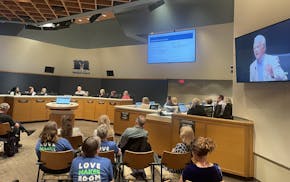No column I've written so far provoked as many reader comments as the one two weeks ago about how small towns in Minnesota are ahead of the rest of the state in experiencing population and workforce decline.
I wanted to do two things in that column. First, amplify some important thoughts and questions from Tuleah Palmer, CEO of the Blandin Foundation in Grand Rapids. It is Minnesota's largest philanthropy outside the Twin Cities and, under Palmer, has reinforced its commitment to keeping rural communities strong and resilient.
Second, as the state experiences slower growth and even decline in some ways, I wanted to say there are lessons from people in smaller Minnesota cities and towns, that I'm keeping my eye out for them and I think you should too.
Reader comments and notes to my email address about that column revealed the hurtful experiences that people in either the urban or rural part of the state have had in the other. For instance, a reader in St. Paul recalled spending junior and senior high in a small town near Grand Rapids and seeing her parents "tormented by the long-time locals."
But one reader in the online comments asked: If this is how things are evolving, who are we to say that's "wrong"?
I ask myself that about a lot of situations. As I reported about the sale of 3M's resort or the proposed merger of the Sanford and Fairview health systems, I've thought that these developments are simply examples of market forces at work.
And, like the reader, I wonder how much should we fight those forces. I believe in free markets and that people tend to be pragmatic, especially when their own money is at stake.
To ignore the resilience of small towns and rural areas, however, requires overlooking how important they are to the wealth and sustainability of big cities and suburbs. People in urban areas rely on the work and creativity of those in rural areas for manufactured goods and food, of course — and, as Palmer noted, increasingly energy.
We need people in rural areas to be living happily, productively and seeing upside in their futures. And people in rural areas need the Twin Cities to prosper too, since the metro area's economic output accounts for 70% or more of our shared economy.
I wish Minnesotans were less divisive on many matters, including geography.
That also goes for perceptions about Minneapolis. In response to my interview with Minneapolis Mayor Jacob Frey about the future of downtown, I heard from many readers who zeroed in on crime as the major challenge to its revitalization. "Don't dance around the issues with rose colored glasses," one reader wrote in an email.
I won't. But neither should readers be overly fearful about life in downtown Minneapolis. Tens of thousands of people still work downtown, and it was packed this past week with people for the Taylor Swift concerts and Pride celebrations.
Downtown Minneapolis is the giant mixing bowl of Minnesotans, where people of all ages and status rub up against one another. Of course, the Minneapolis police have hiring to do and a better department to build. They'll do that and the rest of us will keep striving to do better too.
In some housekeeping, the Minneapolis Public Schools after my column about its superintendent search provided updated figures on the projected deficit in its fiscal 2025, which covers the 2024-25 academic year. That's the period when federal pandemic aid will no longer be available to the district.
I noted that the district would get about $90 million in pandemic grants during the 2023-24 year to show that, without that money, it faces a huge deficit in 2024-25. A day after the column, the district announced that, with some new state aid coming, the deficit it needs to address for 2024-25 will be about $77 million.
On that 3M column, my colleague Christopher Vondracek noted that many people know the lake next to the company's retreat as Big Mantrap Lake, instead of simply Mantrap Lake as I called it. Apologies to his family and all others who live and relax at nearby Little Mantrap Lake.
And in response to my Star Tribune 50 column about the politicization of ESG, Ian Lewenstein, a former staffer in the Legislature's Revisor's Office who is now a legal consultant, wrote to say that I erred by calling ESG an acronym.
It's actually an initialism.
He reminded me that an acronym is read as a single word, like NASA, while an initialism is read as a series of separate letters, like ESPN.
Lewenstein, who helps lawyers and policymakers with their use of language, wrote a persuasive article last year for the Minnesota State Bar Association on why people should be careful when they use abbreviations. Sometimes it's better to spell things out.

Ramstad: Gustavus president Bergman calls aid glitch a 'massive disruption'

Ramstad: Minnetonka council meeting shows compromise on affordable housing is possible

Ramstad: In a tight labor market, job fairs have changed to find people on the margins


